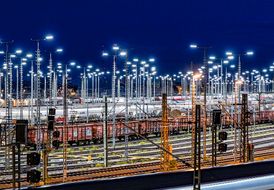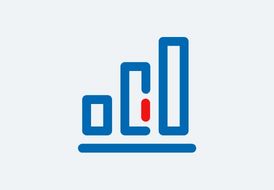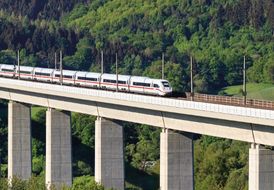Development in the year under review
- Positive performance development due to improved economic environment for sectors predisposed to rail transport.
- Revenue growth was recorded in block train, single wagon and combined transport.
- Extraordinary events dampened development.
DB CARGO | 2021 | 2020 | Change | 2019 | ||
absolute | % | |||||
Punctuality (%) | 69.5 | 76.9 | –7.4 | – | 74.0 | |
Customer satisfaction (SI) | 70 | 68 | +2 | – | 61 | |
Freight carried (million t) | 226.5 | 213.1 | +13.4 | +6.3 | 232.0 | |
Volume sold (million tkm) | 84,850 | 78,670 | +6,180 | +7.9 | 85,005 | |
Volume produced (million train-path km) | 169.0 | 156.8 | +12.2 | +7.8 | 162.5 | |
Capacity utilization (t per train) | 502.0 | 501.7 | +0.3 | +0.1 | 523.2 | |
Total revenues (€ million) | 4,487 | 4,119 | +368 | +8.9 | 4,449 | |
External revenues (€ million) | 4,195 | 3,854 | +341 | +8.8 | 4,188 | |
EBITDA adjusted (€ million) | –100 | –321 | +221 | –68.8 | 13 | |
EBIT adjusted (€ million) | –481 | –728 | +247 | –33.9 | –308 | |
EBIT margin (adjusted) (%) | –10.7 | –17.7 | +7.0 | – | –6.9 | |
Gross capital expenditures (€ million) | 525 | 452 | +73 | +16.2 | 570 | |
Employees as of Dec 31 (FTE) | 30,057 | 30,052 | +5 | – | 29,525 | |
Annual average employees (FTE) | 30,192 | 30,007 | +185 | +0.6 | 29,280 | |
Employee satisfaction (SI) | – | 3.9 | – | – | – | |
Share of women as of Dec 31 (%) | 12.0 | 11.5 | +0.5 | – | 11.5 | |
Specific final energy consumption compared to 2006 (based on tkm) (%) | –23.2 | –23.1 | –0.1 | – | –21.0 | |
The punctuality of DB Cargo declined significantly. This largely relates to the companies in Germany, and is mainly due to the increased again utilization of the rail network and higher construction activity. There were further restrictions resulting from multiple extraordinary events (a severe cold snap in February 2021, a landslide in the Middle Rhine Valley in March 2021, infrastructure damage from heavy rain in the Munich North marshaling yard in June 2021 and floods in July 2021). The GDL strikes also had a negative effect on operations. Punctuality also declined significantly for the companies in Eastern Europe.
In the annual survey carried out in March 2021, customer satisfaction was at the highest level measured to date since survey results started to be collected across Europe. Performance during the Covid-19 pandemic was rated highly by customers.
The performance development was positive. The trend from the second half of 2020 continued. Growth in foreign trade, the significant increase in online shopping due to the Covid-19 pandemic and economic stimuli, particularly from the steel and chemical industry, led to significant improvements over the previous year’s weak figures, which were heavily impacted by the Covid-19 pandemic. This more than compensated for the negative effects from extreme weather events, the landslide on the Rhine line, the consequences of the semiconductor shortage in the automotive industry, the temporary closure of the Great Belt Bridge to trailer traffic and the wage dispute with the GDL.
The economic development improved noticeably, but remains under severe strain. Operating profit figures rose significantly as a result of the increase in income.
- Revenues increased significantly to above pre-Covid-19 levels:
- The main drivers in block train transport were transports of steel, coal, building materials and fertilizers. Among the dampening factors were the decrease in demand for transport of mineral oil products and the wage dispute with the GDL.
- There was growth in single wagon transport, mainly as a result of development in the iron, coal and steel, timber and paper transport sectors. There were also dampening effects from restrictions from the previously mentioned extraordinary events and the temporary closure of the Great Belt Bridge to trailer traffic.
- The increase in combined transport was primarily driven by sustained positive development of transport to and from China. New transport services in Germany also increased revenues.
- Other operating income (+23.9%/€ +103 million) increased largely as a result of higher subsidies (mainly from facility price support).
On the expense side, there were additional burdens, driven by performance in the cost of materials and increased personnel expenses:
- Cost of materials (+5.9%/€ +148 million) increased due to higher expenses for purchased transport services, energy and train paths. This was counteracted in part by positive exchange rate effects.
- Personnel expenses (+4.2%/€ +74 million) increased in all regions, mainly as a result of collective bargaining agreements.
- Other operating expenses (+2.9%/€ +18 million) rose in part due to higher IT expenses and higher costs for training measures.
In contrast, the development of other expense items had a dampening effect:
- The significant decrease in depreciation (–6.4%/€ –26 million) was driven by the absence of one-off effects from the previous year.
Capital expenditures increased, mainly as a result of leasing activities for freight cars.
The number of employees was at the same level as in the previous year.
The share of women increased slightly.
The specific final energy consumption on the rails (traction) compared to the reference year, 2006, remained virtually unchanged.
- Performance gains were achieved due to the economic recovery, particularly in the steel and chemical industry.
- New transport services were introduced in Belgium, and existing services in trans-Eurasian transport were expanded.
- Extraordinary events had a dampening effect.
| CENTRAL EUROPE REGION | 2021 | 2020 | Change | 2019 | ||
absolute | % | |||||
Freight carried (million t) | 231.5 | 214.1 | +17.4 | +8.1 | 225.2 | |
Volume sold (million tkm) | 68,414 | 63,886 | +4,528 | +7.1 | 68,265 | |
Volume produced (million train-path km) | 135.8 | 125.7 | +10.1 | +8.0 | 127.3 | |
Total revenues 1) (€ million) | 5,172 | 4,792 | +380 | +7.9 | 4,959 | |
External revenues 1) (€ million) | 3,470 | 3,192 | +278 | +8.7 | 3,443 | |
EBITDA adjusted 1) (€ million) | –190 | –386 | +196 | –50.8 | –112 | |
EBIT adjusted 1) (€ million) | –459 | –678 | +219 | –32.3 | –333 | |
Gross capital expenditures 1) (€ million) | 385 | 326 | +59 | +18.1 | 456 | |
Employees as of Dec 31 1) (FTE) | 21,882 | 21,865 | +17 | +0.1 | 21,433 | |
1) Previous years figures adjusted due to changes in the presentation of Eurasian transport (from the Eastern Europe region to the Central Europe region).
With respect to performance development in Central Europe, the recovery trend in the steel and chemical industry and in combined transport since the second half of 2020 continued. This was supported by expansions of available offers in Belgium and Italy and on the trans-Eurasian corridor. The effects of the extreme weather events in Germany, the wage dispute with the GDL and the Covid-19-related semiconductor shortage in the automotive industry had a dampening effect. Overall, volumes were higher than before the Covid-19 pandemic.
However, the economic development remains very challenging. Although operating profit figures improved as a result of income gains, they remained negative.
- Revenues increased noticeably due to higher volumes.
- Other operating income increased, mainly as a result of increased subsidies, predominantly from facility price support.
On the expense side, there was a slight increase driven by the cost of materials:
- Cost of materials increased, driven by increased purchases of transport services, as well as train-path and energy expenses as a result of higher volumes. Conversely, lower maintenance costs were among the factors that had a mitigating effect on expenses.
- Personnel expenses also increased, largely as a result of collective bargaining agreements and a higher average number of employees, especially in Germany and Belgium.
- Other operating expenses were at virtually the same level as in the previous year.
In contrast, the decrease in depreciation had a dampening effect:
- Depreciation decreased significantly, largely due to the absence of special items from the previous year (unscheduled software depreciations).
The growth in capital expenditures resulted mainly from higher additions of freight cars.
The number of employees was at the same level as in the previous year.
- Positive effects from recovery-driven increase in demand and train-path price reductions in France.
- Restrictions caused by Brexit in the United Kingdom, the semiconductor shortage and economic weakness in Spain had a dampening effect on development.
- Restructuring was driven forward in France.
| WESTERN EUROPE REGION | 2021 | 2020 | Change | 2019 | ||
absolute | % | |||||
Freight carried (million t) | 45.2 | 40.9 | +4.3 | +10.5 | 46.4 | |
Volume sold (million tkm) | 11,562 | 10,197 | +1,365 | +13.4 | 11,906 | |
Volume produced (million train-path km) | 25.4 | 23.5 | +1.9 | +8.1 | 27.3 | |
Total revenues (€ million) | 708 | 618 | +90 | +14.6 | 675 | |
External revenues (€ million) | 535 | 483 | +52 | +10.8 | 546 | |
EBITDA adjusted (€ million) | 59 | 37 | +22 | +59.5 | 91 | |
EBIT adjusted (€ million) | –30 | –53 | +23 | –43.4 | 15 | |
Gross capital expenditures (€ million) | 84 | 60 | +24 | +40.0 | 82 | |
Employees as of Dec 31 (FTE) | 4,231 | 4,248 | –17 | –0.4 | 4,190 | |
The performance development in Western Europe also grew:
- Developments at DB Cargo UK were positive despite the economic consequences of Brexit, although volumes did not return to pre-Covid-19 levels.
- The situation at DB Cargo France reflects the successes of the restructuring program, which were also bolstered by the economic recovery in France.
- There was a dampening effect from a decline in transport services in Spain. This was attributable both to temporary factory closures in the automotive industry caused by the semiconductor shortage, and to the economic consequences of Brexit for transport between Spain and the United Kingdom.
The economic development improved as a result of increases in volume, but remained challenging. Operating profit figures rose as a result of the increase in income:
- The recovery in demand had a positive effect on revenue development.
- There were dampening effects from lower other operating income as a result of reduced maintenance services for third parties at DB Cargo UK.
Expenses rose slightly:
- Cost of materials increased, largely for volume reasons (higher costs for energy and service procurement). This was partially counteracted by a reduction in train-path prices in France. Adjusted for exchange rates, the increase was less significant.
- Personnel expenses increased as a result of higher pension costs at DB Cargo UK and wage increases.
- Other operating expenses increased for exchange rate reasons; adjusted, they were at the previous year’s level.
- Depreciation was at the previous year’s level.
Capital expenditures increased due to leasing activities.
The number of employees was slightly below the previous year’s level due to restructuring measures in France.
- Covid-19 recovery effects and new transport services had a significantly positive effect, particularly in the Czech Republic.
- Optimization of the product and transport portfolio driven forward.
| EASTERN EUROPE REGION | 2021 | 2020 | Change | 2019 | ||
absolute | % | |||||
Freight carried (million t) | 17.6 | 14.8 | +2.8 | +18.9 | 15.5 | |
Volume sold (million tkm) | 4,875 | 4,587 | +288 | +6.3 | 4,834 | |
Volume produced (million train-path km) | 7.9 | 7.6 | +0.3 | +3.9 | 7.9 | |
Total revenues 1) (€ million) | 319 | 293 | +26 | +8.9 | 304 | |
External revenues 1) (€ million) | 190 | 179 | +11 | +6.1 | 199 | |
EBITDA adjusted 1) (€ million) | 31 | 28 | +3 | +10.7 | 34 | |
EBIT adjusted 1) (€ million) | 8 | 2 | +6 | – | 11 | |
Gross capital expenditures 1) (€ million) | 55 | 37 | +18 | +48.6 | 32 | |
Employees as of Dec 31 1) (FTE) | 3,944 | 3,939 | +5 | +0.1 | 3,902 | |
1) Previous years figures adjusted due to changes in the presentation of Eurasian transport (from the Eastern Europe region to the Central Europe region).
The performance development in Eastern Europe, driven by recovery effects following the decline in transport in 2020 due to the Covid-19 pandemic, increased significantly and exceeded pre-Covid-19 levels. These developments were also bolstered by new transport services in Romania.
The economic development was pleasing: operating profit figures recovered significantly. This was driven by a growth in income:
- Revenues increased significantly, partly as a result of demand. The expansion of available offers in the Czech Republic and additional transport services in Romania also supported this. Exchange rate effects had a dampening effect.
- Other operating income increased, partly as a result of asset sales.
In terms of expenses, there was a clear volume-related increase, although the increase was lower than the increase
in volumes.
- Cost of materials increased significantly, largely as a result of the recovery in demand, an increase in purchased transport services and rising energy costs. Exchange rate effects had a partially compensating effect.
- Personnel expenses increased, largely as a result of collective bargaining agreements. This was also partially compensated for by positive exchange rate effects.
- Other operating expenses also increased. In particular, additional rentals of rolling stock had an effect.
In contrast, the decline in other expense items had a dampening effect:
- Depreciation decreased as a result of lower capital expenditure activities during the business year.
Capital expenditures increased significantly, mainly as a result of the acquisition of locomotives and freight cars in Poland.
The number of employees was at the same level as in the previous year. A volume-related increase in personnel in the Czech Republic and Romania was almost entirely offset by effects from supply adjustments in Poland and Bulgaria.



